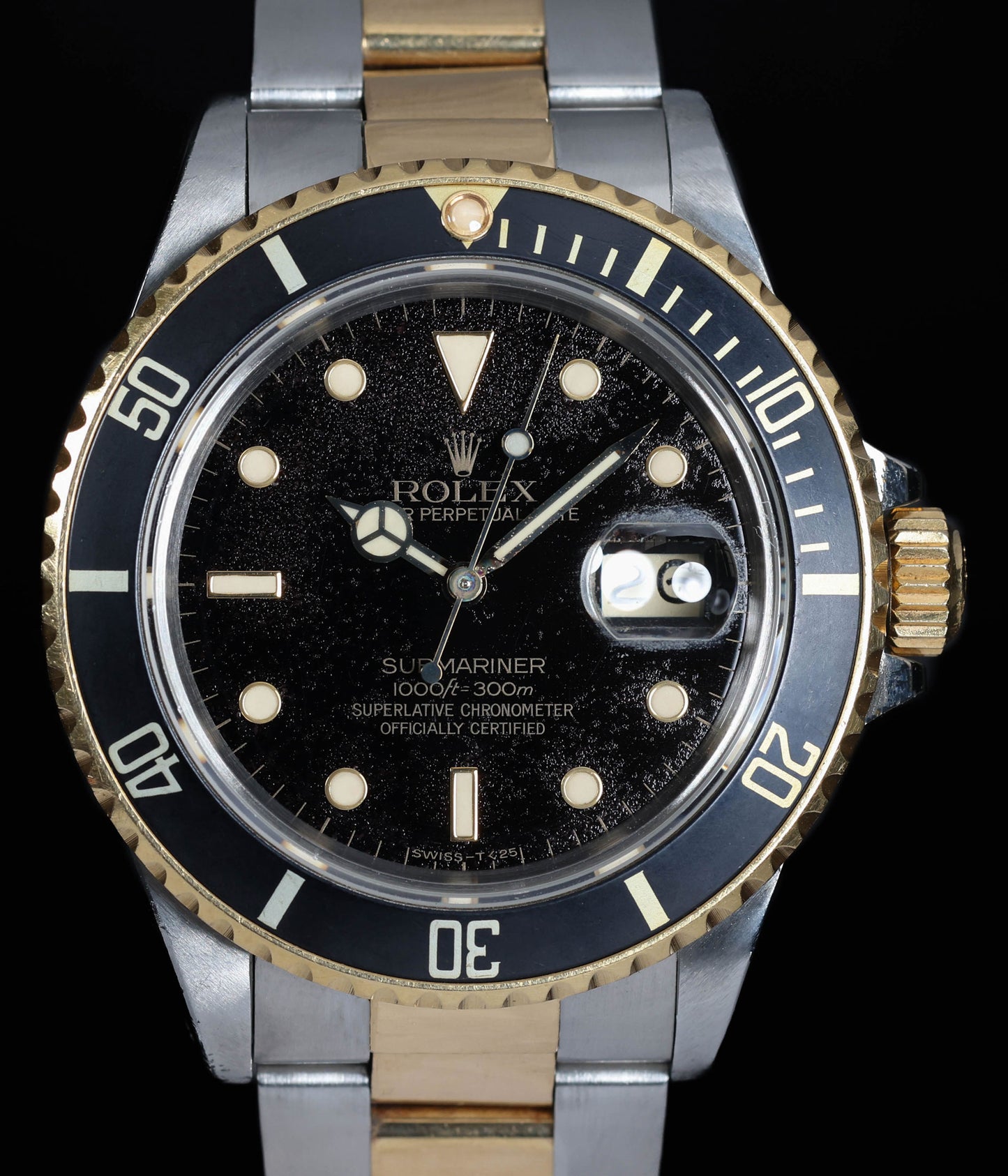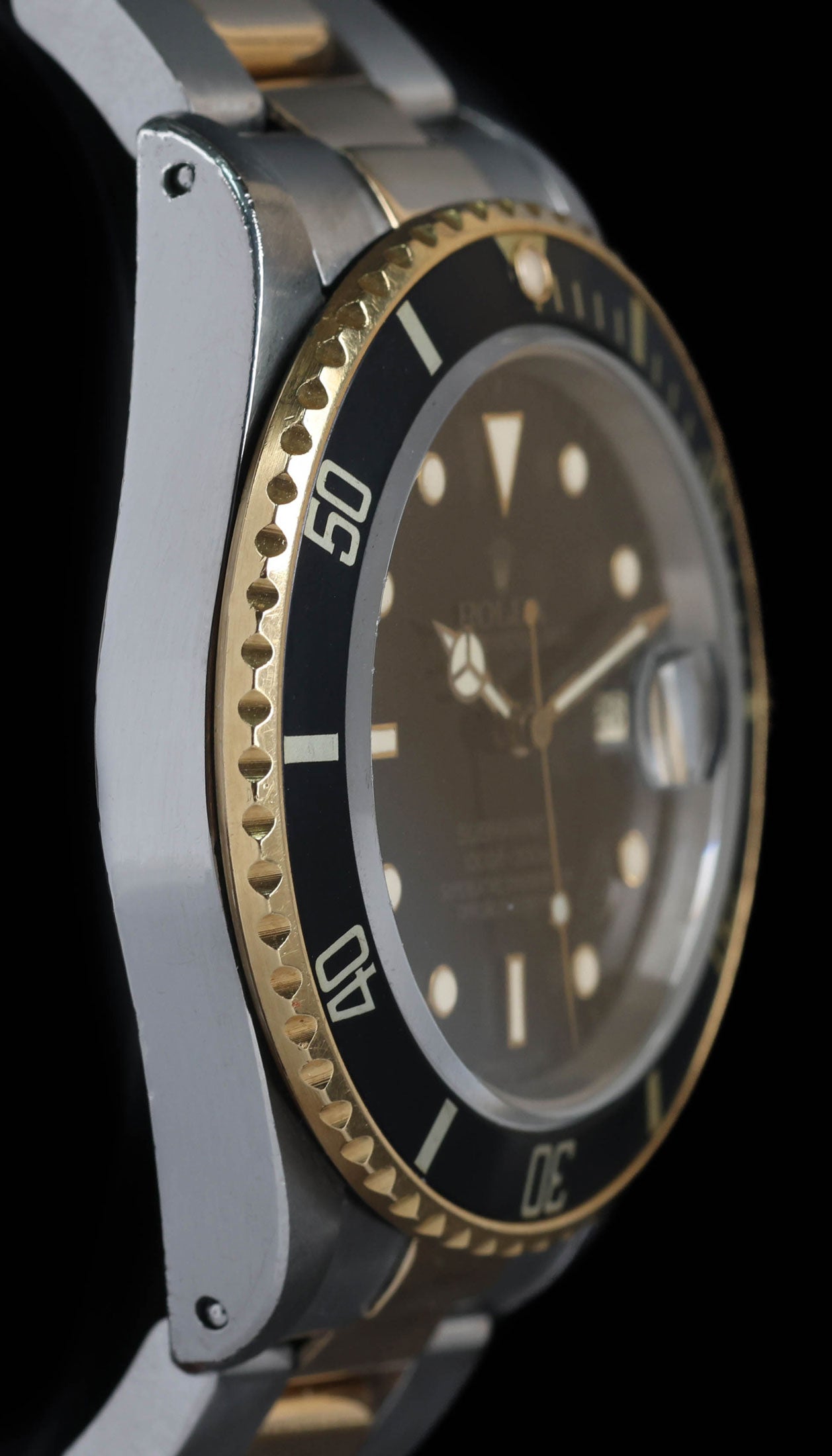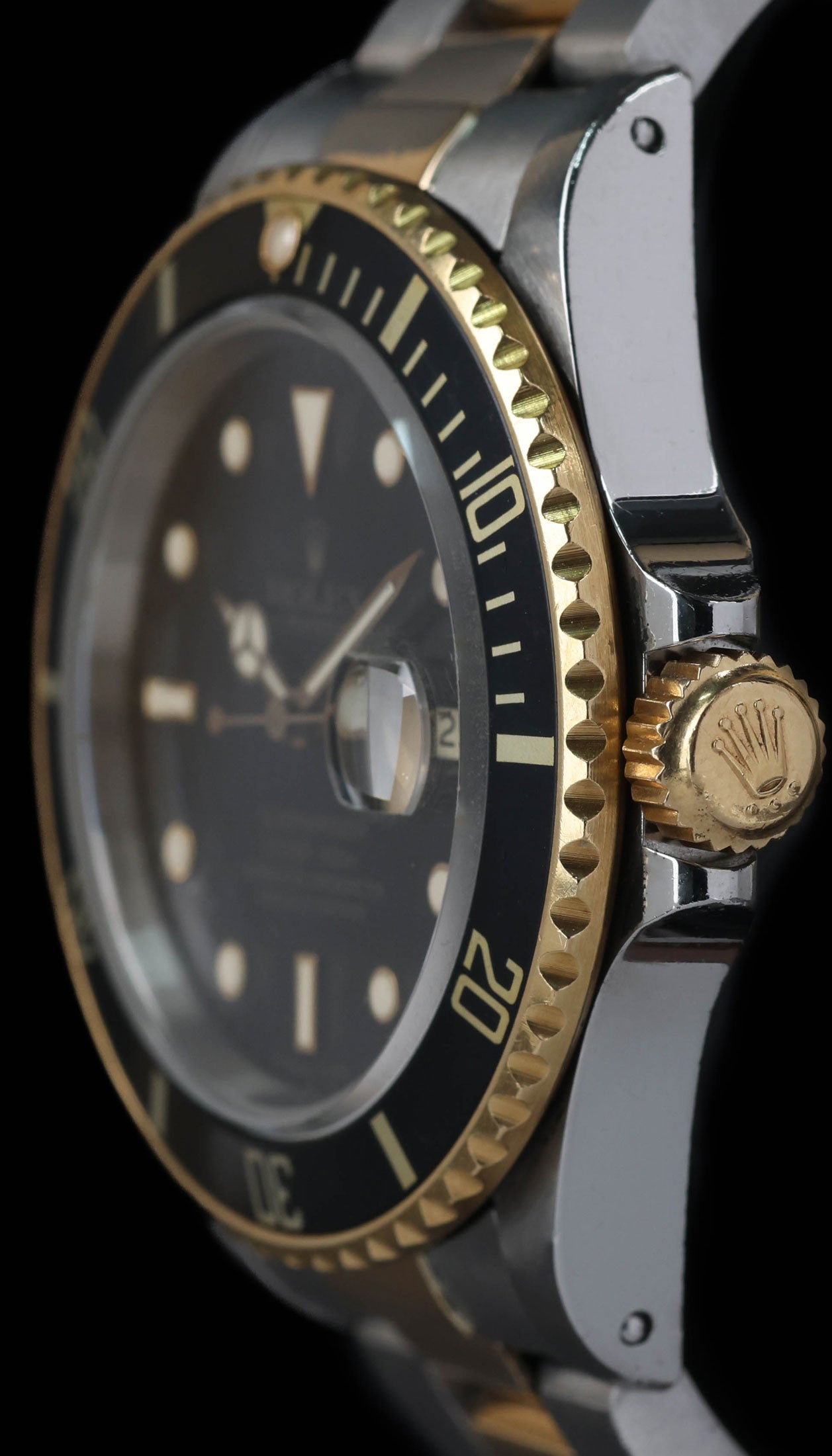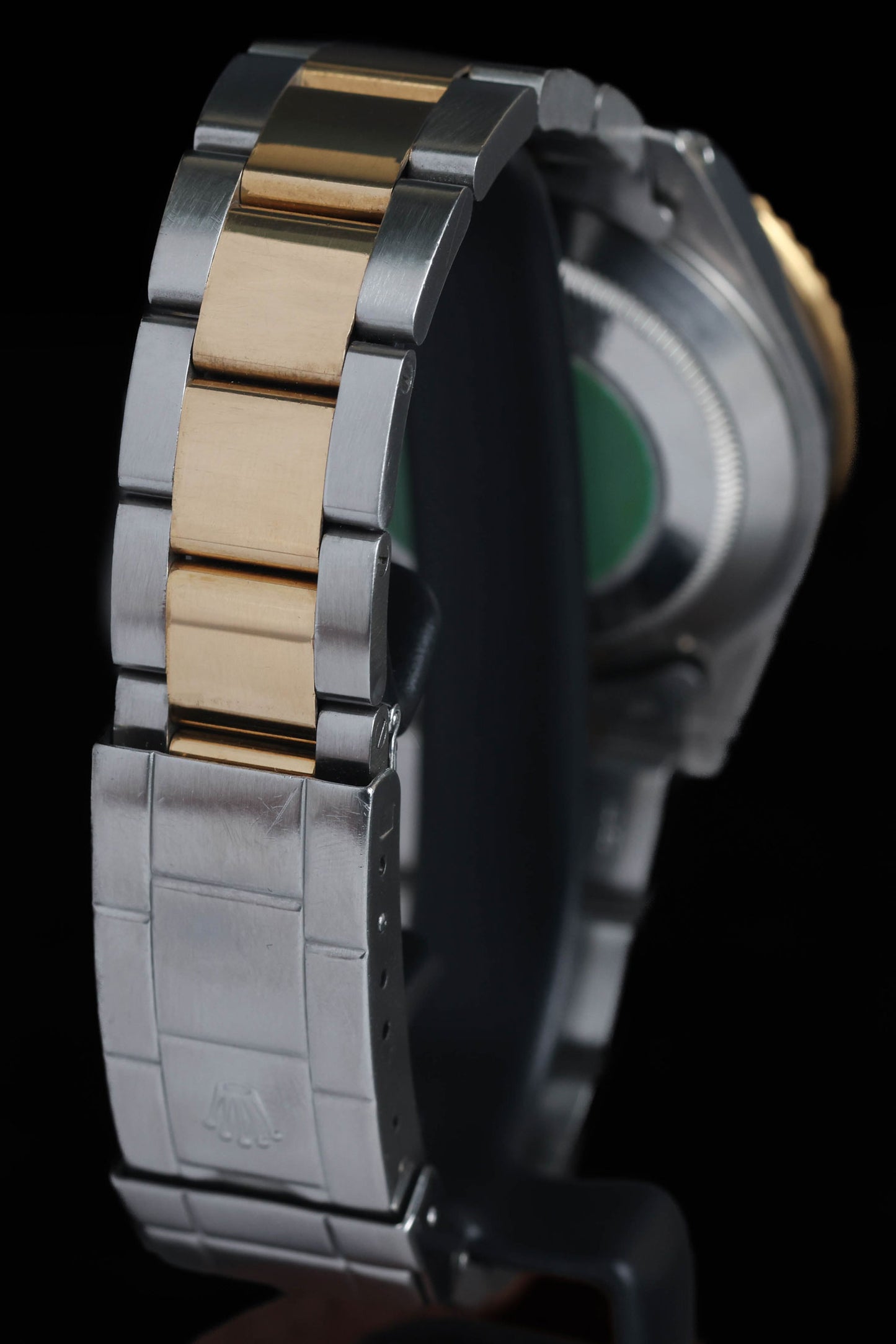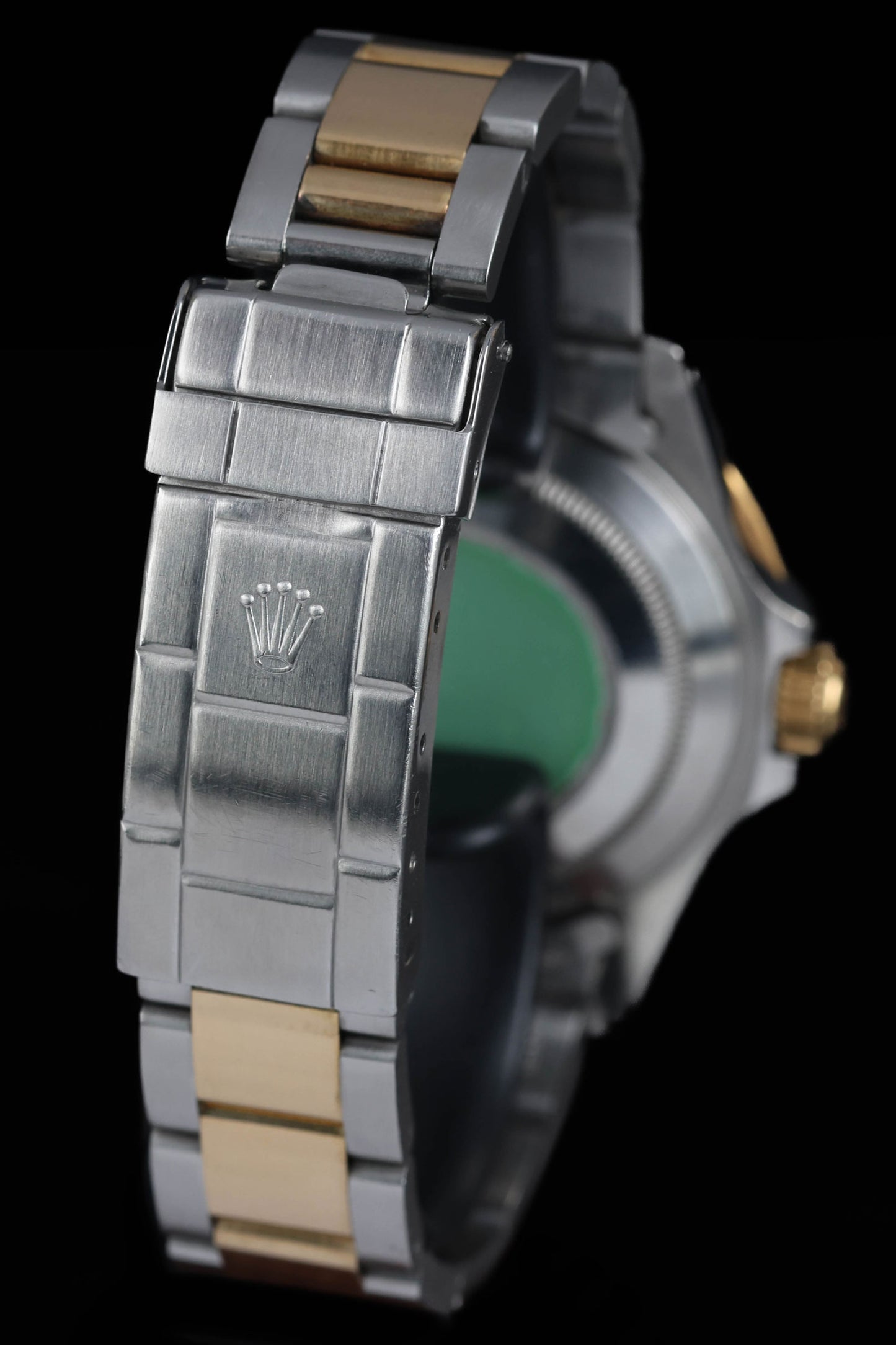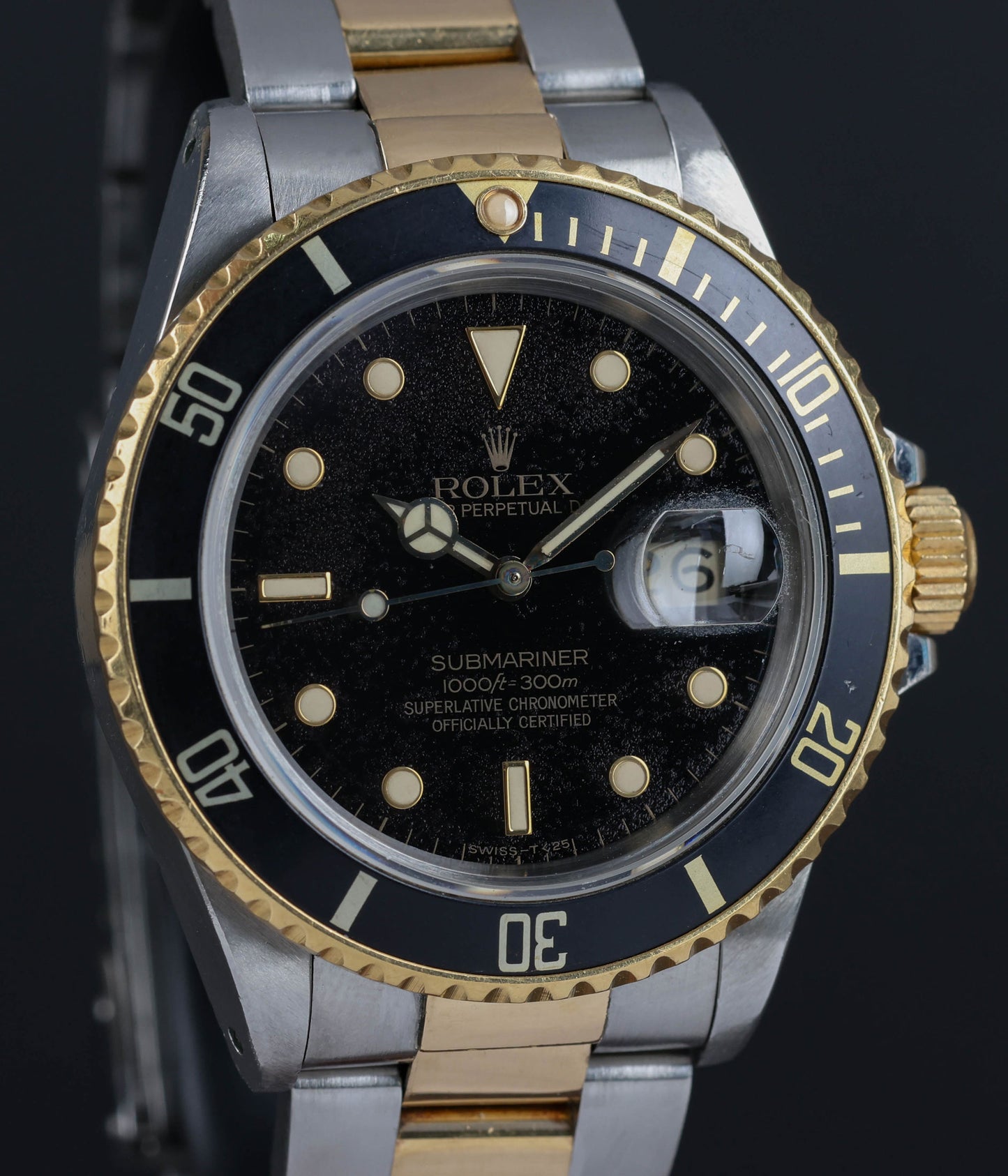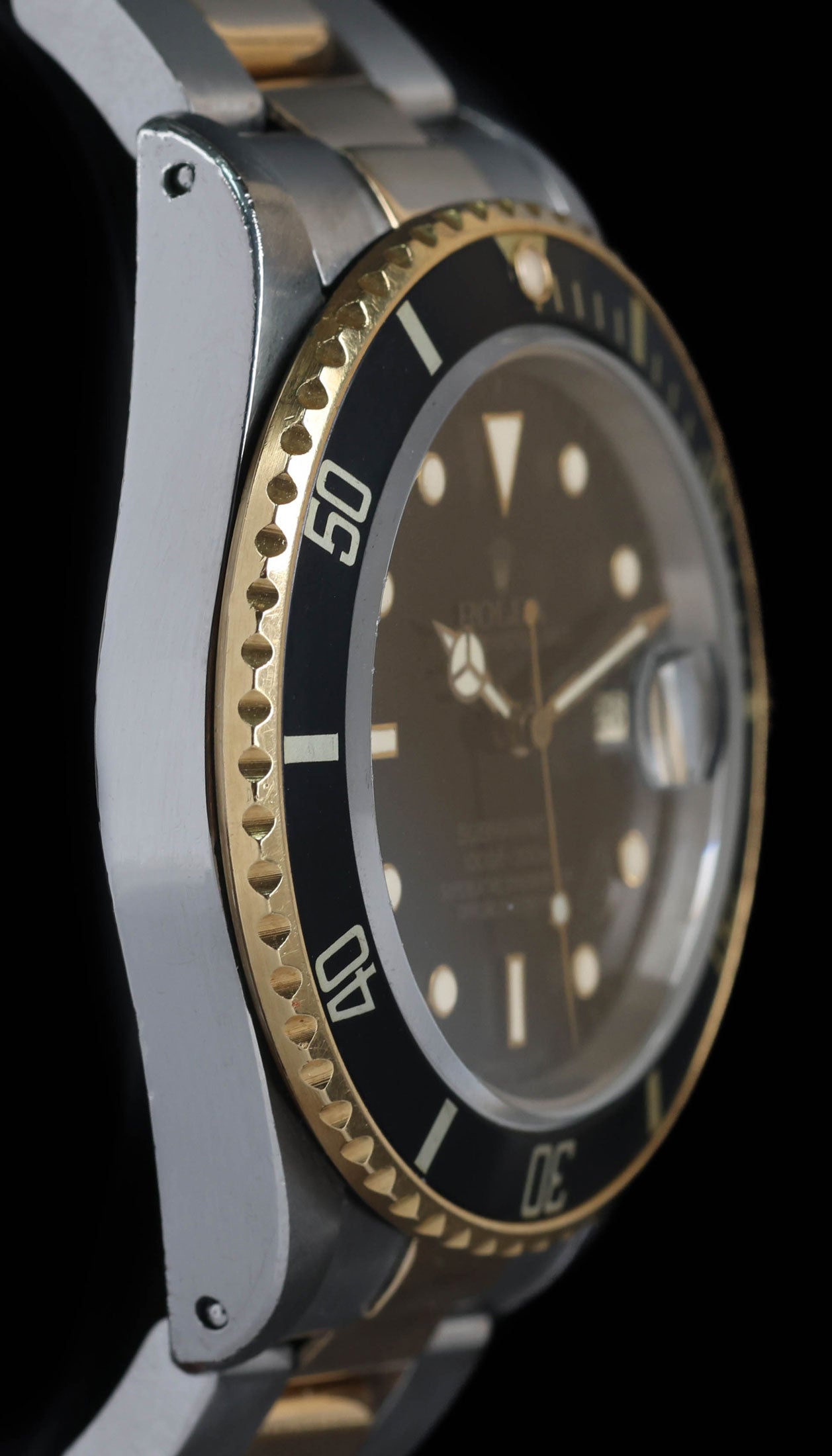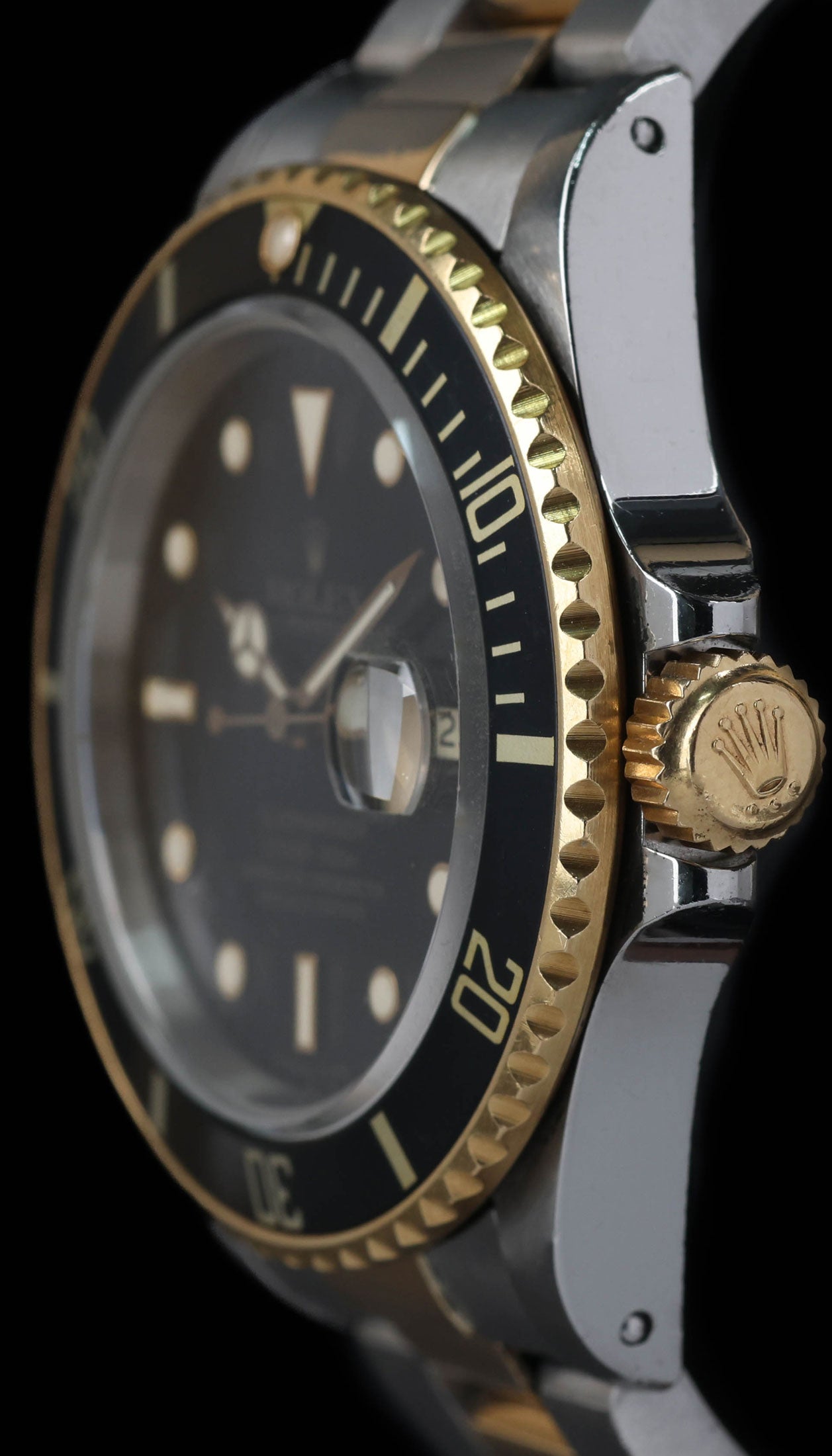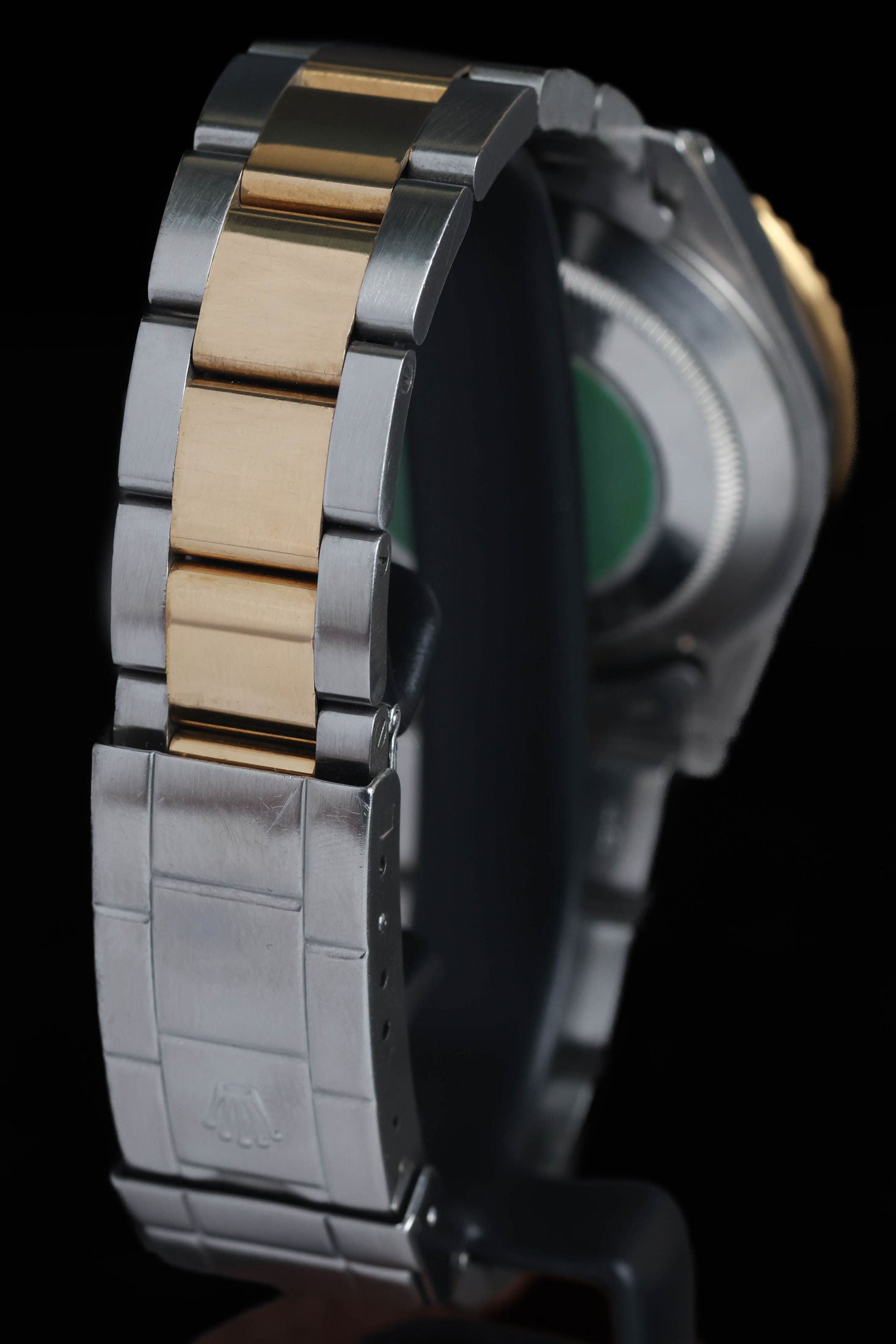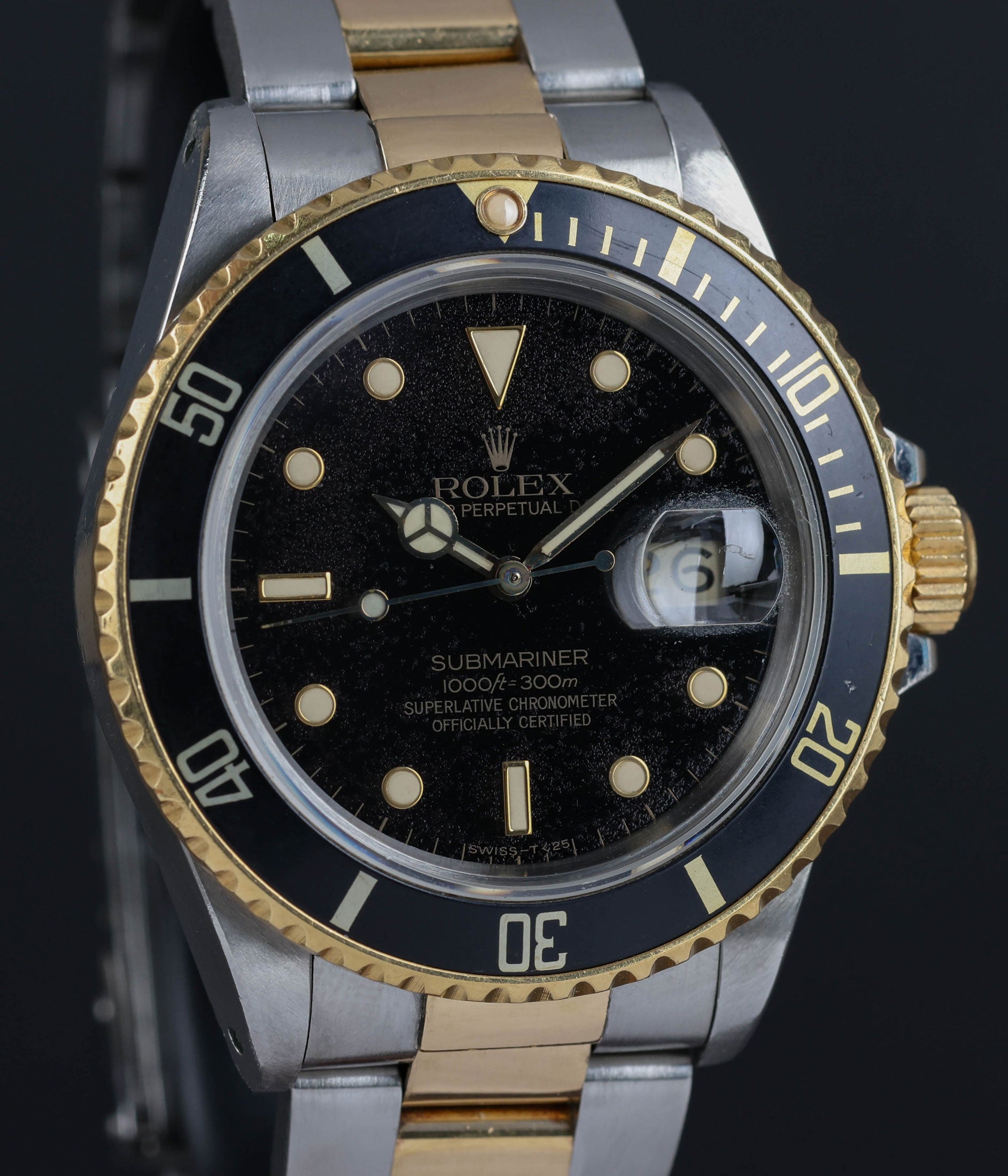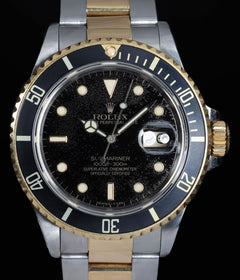Crown Vintage
Rolex Submariner Two-Tone Tropical Stardust 16803 40mm 1988
Rolex Submariner Two-Tone Tropical Stardust 16803 40mm 1988
Couldn't load pickup availability
The Rolex Submariner Two-Tone case is in good vintage condition with sharp lugs that have retained their definition. Both the case and bracelet have undergone light polishing, preserving their original proportions and contours. The dial displays a rare tropical stardust patina, exhibiting an attractive, natural ageing process that enhances the watch’s vintage appeal. The unique patina pattern provides character and individuality, making this piece particularly desirable to collectors. The hands show light oxidation consistent with age, adding to the overall vintage aesthetic. The oxidation remains even and does not compromise legibility or functionality. The bracelet has been lightly polished and is in well-preserved condition, exhibiting minimal stretch and retaining its original structure. This example is an outstanding vintage piece, showcasing desirable features such as sharp lugs, tropical patina, and well-maintained components. It offers exceptional visual appeal while remaining true to its original character.
Share
Why we love this watch
Why we love this watch
Rolex Submariner 16803: A Transitional Milestone in the Submariner Line
The Rolex Submariner 16803 represents a pivotal moment in the evolution of Rolex’s iconic dive watch. Produced from approximately 1983 to 1988, the 16803 was the first two-tone Submariner, combining stainless steel and 18k yellow gold in a design known as Rolesor. Its introduction marked a deliberate move by Rolex to expand the Submariner line from pure tool watch functionality into the luxury sports watch category.
This transitional model served as a bridge between vintage and modern Submariners, incorporating new materials and technological upgrades that laid the groundwork for future references. Alongside the stainless steel 16800 and the all-gold 16808, the 16803 was part of Rolex’s strategy to broaden the appeal of the Submariner, enhancing its durability while simultaneously elevating its aesthetic appeal.
Development and Historical Context
The early 1980s were characterised by significant changes in the luxury watch industry. Quartz technology had reshaped the market, and mechanical watchmakers were forced to adapt. Rolex responded by enhancing the technical performance of its sports watches while also recognising the increasing demand for luxury-oriented designs.
The Rolex Submariner 16803 was introduced as part of a broader effort to modernise the Submariner line. While previous models like the 1680 and 5513 were built for their ruggedness and utilitarian appeal, the 16803 was designed to offer a more upscale option without compromising performance.
By incorporating 18k yellow gold into the case and bracelet alongside stainless steel, Rolex created a watch that was visually striking yet durable. This combination of materials, referred to by Rolex as Rolesor, had already proven successful in the Datejust line. Applying the same concept to the Submariner was a calculated risk that ultimately paid off, broadening the model’s appeal beyond professional divers to include luxury watch buyers.
The 16803 was released concurrently with the stainless steel 16800 and the solid gold 16808, forming a trio of transitional references that would define the Submariner’s aesthetic and technical evolution for years to come.
Technological Advancements
The Rolex Submariner 16803 incorporated several technological improvements over previous models. One of the most significant changes was the introduction of a sapphire crystal, replacing the acrylic crystals used on earlier Submariner references such as the 1680. The sapphire crystal offered superior scratch resistance, improving both durability and clarity.
Additionally, the 16803 featured a unidirectional rotating bezel, a departure from the earlier bi-directional bezels used by Rolex. The unidirectional design enhanced safety for divers, allowing them to accurately track dive times without the risk of accidentally extending them. The bezel insert itself was made of aluminium, with gold-filled numerals and markings that complemented the two-tone design.
The reference 16803 also benefited from improved water resistance, rated at 300 metres (1,000 feet). This enhancement was achieved through the use of Rolex’s Triplock crown system, identifiable by the three dots below the Rolex coronet on the crown. The Triplock crown provided a more robust seal, further protecting the movement from water ingress.
The dial of the 16803 was available in either black or blue, with the latter being particularly popular. The hour markers were applied and surrounded by yellow gold, with luminous tritium paint providing visibility in low-light conditions. The dial text included the “SWISS-T<25” marking at the six o’clock position, indicating the use of tritium as the luminescent material.
Rolex also introduced white gold surrounds for the hour markers during the 16803’s production run. Early examples featured matte dials with painted markers, while later examples utilised glossy dials with applied markers featuring gold surrounds. This transition was part of Rolex’s broader effort to modernise its lineup by improving legibility and aesthetics.
Movement: Calibre 3035
The Submariner 16803 was equipped with Rolex’s Calibre 3035, an automatic movement introduced in 1977 and used extensively throughout the 1980s. The Calibre 3035 was notable for its higher frequency of 28,800 vibrations per hour (vph), which improved both accuracy and the smoothness of the seconds hand’s motion.
Prior to the introduction of the Calibre 3035, Rolex movements such as the Calibre 1575 operated at a frequency of 19,800 vph. The higher frequency of the 3035 represented a significant advancement in terms of precision and reliability.
The Calibre 3035 also featured a quickset date function, a major improvement over previous movements. This feature allowed the wearer to adjust the date independently of the time, providing greater convenience compared to earlier models that required rotating the hour hand repeatedly to change the date.
Like all modern Rolex movements, the Calibre 3035 was certified by the Swiss Official Chronometer Testing Institute (COSC), ensuring accuracy within -4 to +6 seconds per day. The movement also featured a free-sprung balance wheel and Breguet overcoil, components designed to enhance stability and shock resistance.
The Calibre 3035 remained in production until the late 1980s when it was succeeded by the Calibre 3135. Despite its eventual replacement, the 3035 is still regarded as one of Rolex’s most reliable and accurate movements.
Design Characteristics
The aesthetic appeal of the Rolex Submariner 16803 is largely defined by its two-tone construction. By combining stainless steel with 18k yellow gold, Rolex created a watch that was both luxurious and practical. This design choice proved influential, leading to the creation of subsequent two-tone Submariner references such as the 16613 and 116613.
The bracelet of the 16803 was an Oyster design featuring solid gold centre links flanked by stainless steel outer links. It also included a flip-lock clasp with a diver’s extension, allowing the watch to be worn over a wetsuit.
The aluminium bezel insert, featuring gold numerals and markers, was another hallmark of the 16803’s design. While the bezel inserts were originally deep blue or black, many examples have developed patina or fading over time, particularly the blue versions. This natural ageing process is often considered attractive and contributes to the model’s vintage appeal.
The use of tritium for the dial and hands provided effective luminescence when new. Over time, tritium degrades, resulting in a creamy patina that enhances the watch’s vintage character.
Conclusion
The Rolex Submariner 16803 stands as a defining transitional model within the Submariner line. Its combination of stainless steel and yellow gold represented a new direction for the collection, appealing to both traditional sports watch enthusiasts and luxury buyers.
From its upgraded Calibre 3035 movement to the introduction of sapphire crystal and unidirectional bezel, the 16803 laid the foundation for modern Submariners. Though discontinued in the late 1980s, its influence persists in contemporary models. As a reference that bridges the gap between vintage and modern Rolex design, the 16803 remains an important part of the Submariner’s evolution.
Case & Bracelet
Case & Bracelet
- Case is in good vintage condition.
- Sharp lugs with the case and bracelet lightly polished.
Dial & Hands
Dial & Hands
- Hands are lightly oxidised.
- Dial has formed tropical stardust patina.
Warranty & Condition
Warranty & Condition
Crown Vintage Watches provides a minimum 3-month mechanical warranty on pre-owned watches, from the date of purchase.
The warranty covers mechanical defects only.
The warranty does not cover damages such as scratches, finish, crystals, glass, straps (leather, fabric or rubber damage due to wear and tear), damage resulting from wear under conditions exceeding the watch manufacturer’s water resistance limitations, and damage due to physical and or accidental abuse.
Please note, water resistance is neither tested nor guaranteed.
Shipping and insurance costs for warranty returns to us must be covered by the customer. Returns must be shipped via traceable courier. Return shipment must be pre-paid and fully insured. Collect shipping will be refused. In case of loss or damages, the customer is liable.
Our Pledge
At Crown Vintage Watches, we stand by the authenticity of every product we sell. For added peace of mind, customers are welcome to have items independently authenticated at their own expense.
Condition
Due to the nature of vintage timepieces, all watches are sold as is. We will accurately describe the current condition and working order of all watches we sell to the best of our ability.
Shipping & Refund
Shipping & Refund
